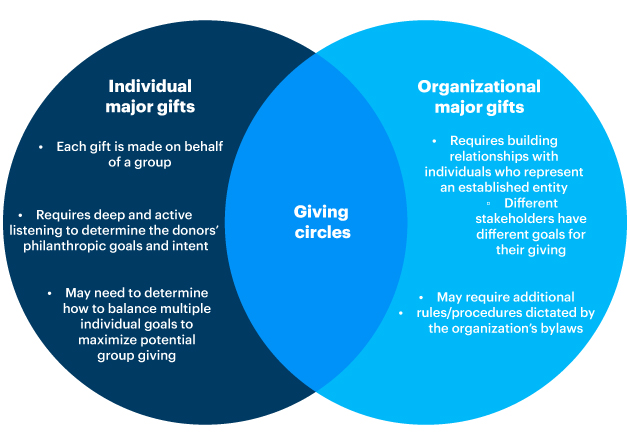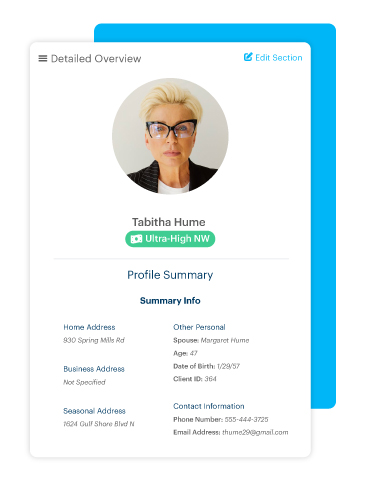Nonprofit Technology & Fundraising Blog
Subscribe to our mailing list

April 29, 2025 | Donor Acquisition, Donor Engagement, Major Donors
One of my best friends in college (hi, Alex!) made it no secret that he was able to attend school thanks to a full scholarship from a very generous donor. He would go out to dinner with his donor at least once per semester, and they were regularly in touch throughout the school year for networking and mentorship opportunities. They developed a close relationship, and it was a deeply meaningful experience for both of them. All of us living, studying, and working with Alex benefited enormously from his presence, too.
When my friends and I approached graduation, we started talking about paying it forward with a scholarship of our own, in honor of the house we shared. Our dream of one day funding the Hill Street Scholarship represents an effective and untapped donor niche: giving circles. Alone, none of us has the wealth needed to cover a student’s full tuition, room and board, books, and incidentals for four years of study. And as individual donors to our large university, none of us quite felt like we were making the impact we wanted to make.
But with eight of us, and the networks we bring…funding a full ride starts to feel a lot more possible. This kind of collective generosity, where a group creates more impact than any individual alone, is exactly what giving circles are all about.
A giving circle is a group of individuals who come together to form a voluntary philanthropic association to donate their money, time, expertise, or some combination. They typically have an informal and independent structure.
Between the US and Canada, giving circles have a long history of generosity between collections of private individuals. The Scots’ Charitable Society, founded in 1657 in Massachusetts, holds the record of the longest-running charitable organization in the Western Hemisphere. Their mission, “Scots helping Scots,” succinctly describes the core of a giving circle: mutual aid and community-based philanthropy.
Giving circles experienced a more modern resurgence in the 1990s and beyond, with the advent of the internet connecting people with similar interests, passions, and goals for their giving. By 2016, the Women’s Philanthropy Institute at Indiana University developed a database of about 1,600 giving circles—and that’s just giving circles that opt in to being counted!
Giving circles fall in the gray area between individual giving and organizational giving, which brings unique challenges and opportunities for smart fundraisers. They aren’t beholden to shareholders or regulations that might impede organizational giving, so you have more freedom to get creative with your proposals, and you can have greater flexibility with your timeline without hard-and-fast due dates and reporting requirements from grant funders.
Pro tip: As you start to work with giving circles, make sure you learn how each would like to receive updates and reports. You might be able to treat some giving circles with the same strategy as individual major donors, and others might prefer to be communicated with as a group.
At the same time, the whole of a giving circle is certainly greater than the sum of its parts. Savvy fundraisers will get to know each member of a giving circle individually–after all, each of them is independently interested in your mission, and could be a planned or major giving prospect down the line. Just don’t forget to keep track of group dynamics and understand their potential impact on overall giving.
So, how is a fundraiser supposed to interact with giving circles in a way that’s both meaningful and time-effective? Try listing the essential elements of your major gifts strategy and your organizational gifts approach and seeing how they overlap.

Now that you have some background and a handle on what makes a giving circle tick, it’s time to connect them to your mission. Let’s break down your giving circle strategy the same way you would with other types of donors: plan how to acquire, engage, ask, and steward these groups of givers.
Brainstorm a list of people in and near your community who that might form giving circles. Think about what motivates people in your life to take collective action. Here’s a short list to get you started:
If you want to find pre-existing giving circles, take advantage of digital databases and resources. Charity Navigator’s Giving Circle Finder can connect you with giving circles from a database of over 4,000 groups. It’s free, with no catch—I tested it for my own volunteer fundraising!
Want to encourage your current community to form their own giving circles? Many people are unfamiliar with giving circles and would love to join one if they had the right information. Add a new section to your nonprofit’s website explaining what giving circles are, how they benefit donors and nonprofits, and how interested readers can get started.
Like with any group of people, the whole of a giving circle is greater than the sum of its parts. There is something special about the connection between each member of the circle that inspires them to give in a way that individual giving might not, so pay attention to the interpersonal dynamics when given the opportunity.
One way to get a sense of a giving circle’s group dynamics is to invite them for their own site visit or get-to-know-you meeting. Give them an inside look into your operations and in return, you’ll get an inside look into their motivations for giving together.
Pro tip: While engaging with a giving circle, start thinking of how they might want to be asked. One group may want a glossy proposal, while another might want to hash the whole thing out over dinner—with or without you in the room!
Remember that each member of a giving circle has their own motivations and may want to connect differently with your nonprofit. Use your CRM to keep track of individual preferences like how they’d like to stay in touch and receive updates from you.
One ask does not fit all giving circles! The less formal nature of giving circles means fundraisers have the freedom to get creative and sophisticated with their asks. Craft an ask that recognizes each member of the giving circle, but above all, captures the spirit of the group.
While some giving circles may prefer equal contributions from their members, it’s unlikely that every member of a giving circle will have equal capacity and inclination for giving. With a promising giving circle, try meeting with each donor individually (or as many as you can) to get a sense of their individual giving goals before returning to the group with an aggregated ask. This offers each member of the giving circle privacy while respecting their differences and maximizes their group giving.

Feel confident by backing your asks with data. Use DonorSearch to learn more about a prospect’s giving capacity, history, appropriate ask amounts, and more.
From here, be prepared to accept gifts in a variety of ways. Some giving circles may give with one check and handle individual contributions privately, and some may prefer to have their members give to your nonprofit directly. Either way, be sure to accurately credit each member of a giving circle for their giving—either legal credit for the writer of the check(s) or soft credit for those involved with the gift, but don’t require a tax receipt from your nonprofit.
Pro tip: Offer matching gift challenge opportunities or support in launching peer-to-peer fundraising campaigns to giving circles as a way to increase their impact!
No matter their backgrounds, the members of a giving circle connected and decided to give together. That’s a beautiful thing worth celebrating! Offer stewardship touchpoints that honor each donor’s contribution and the overall value of their group effort.
For giving circles that are local to you, be sure to offer in-person opportunities to connect, not just to get face time with donors, but to let giving circle members enjoy time with each other. Take every opportunity you have to make a giving experience enjoyable for your donors—it helps keep them close to your mission and primes them for sustained and upgraded giving.
For donors who are further away, you don’t have to sacrifice the personal connection. Create virtual or hybrid experiences that showcase each giving circle’s impact on your programs. You can send packages or special cards in the mail to add a physical element to a long-distance experience.
Calling all DonorPerfect users: Take advantage of the features in your system to tap into your local network of giving circles and form a few of your own! Here are some ideas to get started. You can always find more information in the DonorPerfect Knowledgebase and in our blog, free guides, and expert webcasts.
No matter who is giving and how, DonorPerfect can help you streamline your fundraising efforts and manage them all in one place. DonorPerfect users raise 25% more funding in their first year with us, with many seeing results within the first six months. Ready to level up your fundraising? Sign up for a personal demo to see DonorPerfect in action.
Follow us on social!